Calculus For Dummies, 2nd Edition (2014)
Part V. Integration and Infinite Series
Chapter 19. Infinite Series
IN THIS CHAPTER
Segueing from sequences into series
An infinite series — the rain delays just wouldn’t end
Getting musical with the harmonic series
Taking a close look at telescoping series
Rooting for the root test
Testing for convergence
Analyzing alternating series
As with just about every topic in calculus, the subject of this chapter involves the idea of infinity — specifically, series that continue to infinity. An infinite series is the sum of an endless list of numbers like ![]() Because the list is unending, it’s not surprising that such a sum can be infinite. What’s remarkable is that some infinite series add up to a finite number. This chapter covers ten tests for deciding whether the sum of a series is finite or infinite.
Because the list is unending, it’s not surprising that such a sum can be infinite. What’s remarkable is that some infinite series add up to a finite number. This chapter covers ten tests for deciding whether the sum of a series is finite or infinite.
What you do in this chapter is quite fantastic when you think about it. Consider the series ![]() If you go out far enough, you’ll find a number that has so many zeros to the right of the decimal point that even if each zero were as small as a proton, there wouldn’t be enough room in the entire universe just to write it down! As vast as our universe is, anything in it — say the number of elementary particles — is a proverbial drop in the bucket next to the things you look at in this chapter. Actually, not even a drop in the bucket, because next to infinity, any finite thing amounts to nothing. You’ve probably heard Carl Sagan get emotional about the “billions and billions” of stars in our galaxy. “Billions and billions” — pffffftt.
If you go out far enough, you’ll find a number that has so many zeros to the right of the decimal point that even if each zero were as small as a proton, there wouldn’t be enough room in the entire universe just to write it down! As vast as our universe is, anything in it — say the number of elementary particles — is a proverbial drop in the bucket next to the things you look at in this chapter. Actually, not even a drop in the bucket, because next to infinity, any finite thing amounts to nothing. You’ve probably heard Carl Sagan get emotional about the “billions and billions” of stars in our galaxy. “Billions and billions” — pffffftt.
Sequences and Series: What They’re All About
Here’s a sequence: ![]() Change the commas to addition signs and you’ve got a series:
Change the commas to addition signs and you’ve got a series: ![]() Pretty simple, eh? Investigating series is what this chapter is all about, but I need to briefly discuss sequences to lay the groundwork for series.
Pretty simple, eh? Investigating series is what this chapter is all about, but I need to briefly discuss sequences to lay the groundwork for series.
Stringing sequences
A sequence is simply a list of numbers. An infinite sequence is an unending list of numbers. That’s the only kind we’re interested in here, and whenever the term sequence (or series) is used alone in this chapter, it means an infinite sequence (or infinite series).
Here’s the general form for an infinite sequence:
![]()
where n runs from 1 (usually) to infinity (sometimes n starts at zero or another number). The fourth term of this sequence, for example, is ![]() (read “a sub 4”); the nth term is
(read “a sub 4”); the nth term is ![]() (read “a sub n”). The thing we care about is what happens to a sequence infinitely far out to the right, or as mathematicians say, “in the limit.” A shorthand notation for this sequence is
(read “a sub n”). The thing we care about is what happens to a sequence infinitely far out to the right, or as mathematicians say, “in the limit.” A shorthand notation for this sequence is ![]() .
.
A few paragraphs back, I mentioned the following sequence. It’s defined by the formula ![]() :
:
![]()
What happens to this sequence as n approaches infinity should be pretty easy to see. Each term gets smaller and smaller, right? And if you go out far enough, you can find a term as close to zero as you want, right? So,
![]()
Recall from Chapters 7 and 8 how to interpret this limit: As n approaches infinity (but never gets there), ![]() gets closer and closer to zero (but never gets there).
gets closer and closer to zero (but never gets there).
Convergence and divergence of sequences
Because the limit of the previous sequence is a finite number, you say that the sequence converges.
 Convergence and divergence: For any sequence
Convergence and divergence: For any sequence ![]() , if
, if ![]() , where L is a real number, then the sequence converges to L. Otherwise, the sequence is said to diverge.
, where L is a real number, then the sequence converges to L. Otherwise, the sequence is said to diverge.
Sequences that converge sort of settle down to some particular number — plus or minus some miniscule amount — after you go out to the right far enough. Sequences that diverge never settle down. Instead, diverging sequences might …
· Increase forever, in which case ![]() . Such a sequence is said to “blow up.” A sequence can also have a limit of negative infinity.
. Such a sequence is said to “blow up.” A sequence can also have a limit of negative infinity.
· Oscillate (go up and down) like the sequence ![]()
· Exhibit no pattern at all — this is rare.
Sequences and functions go hand in hand
The sequence ![]() can be thought of as an infinite set of discrete points (discrete is a fancy math word for separate) along the continuous function
can be thought of as an infinite set of discrete points (discrete is a fancy math word for separate) along the continuous function ![]() . Figure 19-1 shows the curve
. Figure 19-1 shows the curve ![]() and the points on the curve that make up the sequence.
and the points on the curve that make up the sequence.
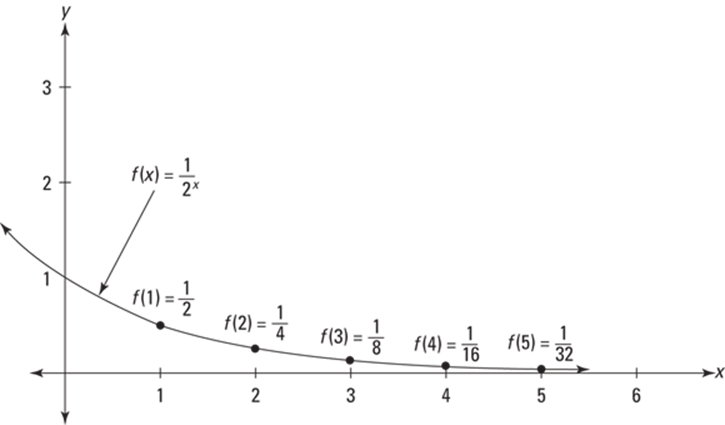
FIGURE 19-1: The points on the curve ![]() make up the sequence
make up the sequence ![]() .
.
The sequence is made up of the outputs (the y-values) of the function where the inputs (the x-values) are positive integers (1, 2, 3, 4, … ).
A sequence and the related function go hand in hand. If the limit of the function as x approaches infinity is some finite number, L, then the limit of the sequence is also L, and thus, the sequence converges to L. Also, the graph of such a convergent function/sequence pair has a horizontal asymptote at ![]() ; the graph in Figure 19-1 has an asymptote with the equation
; the graph in Figure 19-1 has an asymptote with the equation ![]() .
.
Determining limits with L’Hôpital’s rule
Remember L’Hôpital’s rule from Chapter 18? You’re going to use it now to find limits of sequences. Does the sequence ![]() converge or diverge? By plugging in 1, then 2, then 3, and so on into
converge or diverge? By plugging in 1, then 2, then 3, and so on into ![]() , you generate the first few terms of the sequence:
, you generate the first few terms of the sequence:
![]()
What do you think? After going up for a couple terms, the sequence goes down and it appears that it’ll keep going down — looks like it will converge to zero. L’Hôpital’s rule proves it. You use the rule to determine the limit of the function ![]() , which goes hand in hand with the sequence
, which goes hand in hand with the sequence ![]() .
.
 Take two separate derivatives. To use L’Hôpital’s rule, take the derivative of the numerator and the derivative of the denominator separately; you do not use the quotient rule.
Take two separate derivatives. To use L’Hôpital’s rule, take the derivative of the numerator and the derivative of the denominator separately; you do not use the quotient rule.
For this problem, you have to use L’Hôpital’s rule twice:
![]()
Because the limit of the function is 0, so is the limit of the sequence, and thus the sequence ![]() converges to zero.
converges to zero.
Summing series
An infinite series (or just series for short) is simply the adding up of the infinite number of terms of a sequence. Here’s the sequence from the previous section again, ![]() :
:
![]()
And here’s the series associated with this sequence:
![]()
You can use fancy summation notation to write this sum in a more compact form:
![]()
The summation symbol tells you to plug 1 in for n, then 2, then 3, and so on, and then to add up all the terms (more on summation notation in Chapter 14). Nitpickers may point out that you can’t actually add up an infinite number of terms. Okay, so here’s the fine print for the nitpickers. An infinite sum is technically a limit. In other words,
![]()
To find an infinite sum, you take a limit — just like you do for improper (infinite) integrals (see Chapter 18). From here on, though, I just write infinite sums like ![]() and dispense with the limit mumbo jumbo.
and dispense with the limit mumbo jumbo.
Partial sums
Continuing with the same series, take a look at how the sum grows by listing the “sum” of one term (kind of like the sound of one hand clapping), the sum of two terms, three terms, four, and so on:
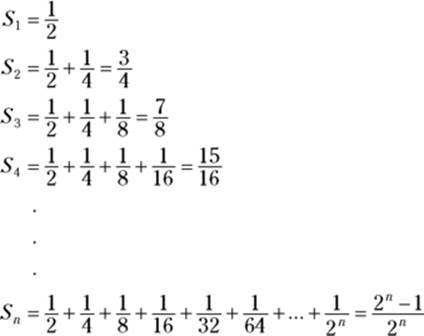
Each of these sums is called a partial sum of the series.
 Partial sum: The nth partial sum,
Partial sum: The nth partial sum, ![]() , of an infinite series is the sum of the first n terms of the series.
, of an infinite series is the sum of the first n terms of the series.
The convergence or divergence of a series — the main event
If you now list the preceding partial sums, you have the following sequence of partial sums:
![]()
The main point of this chapter is figuring out whether such a sequence of partial sums converges — homes in on a finite number — or diverges. If the sequence of partial sums converges, you say that the series converges; otherwise, the sequence of partial sums diverges and you say that the series diverges. The rest of this chapter is devoted to the many techniques used in making this determination.
By the way, if you’re getting a bit confused by the terms sequence and series and the connection between them, you’re not alone. Keeping the ideas straight can be tricky. For starters, note that there are two sequences associated with every series. With the series ![]() , for example, you have the underlying sequence,
, for example, you have the underlying sequence, ![]() , and also the sequence of partial sums,
, and also the sequence of partial sums, ![]() . It’s not a bad idea to try to keep these things straight, but all you really need to worry about is whether the series adds up to some finite number or not. If it does, it converges; if not, it diverges. The reason for getting into the somewhat confusing notion of a sequence of partial sums is that the definitions of convergence and divergence are based on the behavior of sequences, not series. But — I hope it goes without saying — ideas are more important than terminology, and again, the important idea you need to focus on is whether or not a series sums up to a finite number.
. It’s not a bad idea to try to keep these things straight, but all you really need to worry about is whether the series adds up to some finite number or not. If it does, it converges; if not, it diverges. The reason for getting into the somewhat confusing notion of a sequence of partial sums is that the definitions of convergence and divergence are based on the behavior of sequences, not series. But — I hope it goes without saying — ideas are more important than terminology, and again, the important idea you need to focus on is whether or not a series sums up to a finite number.
What about the previous series? Does it converge or diverge? It shouldn’t take too much imagination to see the following pattern:
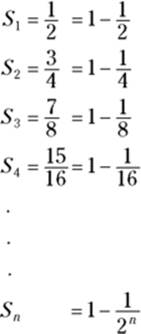
Finding the limit of this sequence of partial sums is a no brainer:
![]()
So, this series converges to 1. In symbols,
![]()
By the way, this may remind you of that paradox about walking toward a wall, where your first step is halfway to the wall, your second step is half of the remaining distance, your third step is half the remaining distance, and so on. Will you ever get to the wall? Answer: It depends. More about that later.
Convergence or Divergence? That Is the Question
This section contains nine ways of determining whether a series converges or diverges. (Then, in the next section on alternating series, we look at a final tenth test for convergence/divergence.) Note that all of the series we investigate in this section are made up of positive terms.
A no-brainer divergence test: The nth term test
If the individual terms of a series (in other words, the terms of the series’ underlying sequence) do not converge to zero, then the series must diverge. This is the nth term test for divergence.
 The nth term test: If
The nth term test: If ![]() , then
, then ![]() diverges. (I presume you figured out that with this naked summation symbol, n runs from 1 to infinity.)
diverges. (I presume you figured out that with this naked summation symbol, n runs from 1 to infinity.)
(Note: The nth term test not only works for ordinary positive series like the ones in this section, it also works for series with positive and negative terms. More about this at the end of this chapter in the “Alternating Series” section.)
If you think about it, the nth term test is just common sense. When a series converges, the sum is homing in on a certain number. The only way this can happen is when the numbers being added are getting infinitesimally small — like in the series I’ve been talking about: ![]() Imagine, instead, that the terms of a series are converging, say, to 1, like in the series
Imagine, instead, that the terms of a series are converging, say, to 1, like in the series ![]() generated by the formula
generated by the formula ![]() . In that case, when you add up the terms, you are adding numbers extremely close to 1 over and over and over forever — and this must add up to infinity. So, in order for a series to converge, the terms of the series must converge to zero. But make sure you understand what this nth term test does not say.
. In that case, when you add up the terms, you are adding numbers extremely close to 1 over and over and over forever — and this must add up to infinity. So, in order for a series to converge, the terms of the series must converge to zero. But make sure you understand what this nth term test does not say.
 When the terms of a series converge to zero, that does not guarantee that the series converges. In hifalutin’ logicianese — the fact that the terms of a series converge to zero is a necessary but not sufficientcondition for concluding that the series converges to a finite sum.
When the terms of a series converge to zero, that does not guarantee that the series converges. In hifalutin’ logicianese — the fact that the terms of a series converge to zero is a necessary but not sufficientcondition for concluding that the series converges to a finite sum.
Because this test is often very easy to apply, it should be one of the first things you check when trying to determine whether a series converges or diverges. For example, if you’re asked to determine whether ![]() converges or diverges, note that every term of this series is a number greater than 1 being raised to a positive power. This always results in a number greater than 1, and thus, the terms of this series do not converge to zero, and the series must therefore diverge.
converges or diverges, note that every term of this series is a number greater than 1 being raised to a positive power. This always results in a number greater than 1, and thus, the terms of this series do not converge to zero, and the series must therefore diverge.
Three basic series and their convergence/divergence tests
In this subsection, we look at geometric series, p-series, and telescoping series. Geometric series and p-series are relatively simple but important series that, in addition to being interesting in their own right, can be used as benchmarks when determining the convergence or divergence of more complicated series. Telescoping series don’t come up much, but many calculus texts describe them, so who am I to buck tradition?
Geometric series
A geometric series is a series of the form
![]()
The first term, a, is called the leading term. Each term after the first equals the preceding term multiplied by r, which is called the ratio.
For example, if a is 5 and r is 3, you get
![]()
You just multiply each term by 3 to get the next term. By the way, the 3 in this example is called the ratio because the ratio of any term divided by its preceding term equals 3, but I think it makes a lot more sense to think of the 3 as your multiplier.
If a is 100 and r is 0.1, you get
![]()
If that rings a bell, you’ve got a good memory. It’s the series for the Achilles versus the tortoise paradox (go way back to Chapter 2).
And if a is ![]() and r is also
and r is also ![]() , you get the series I’ve been talking so much about:
, you get the series I’ve been talking so much about:
![]()
The convergence/divergence rule for geometric series is a snap.
 Geometric series rule: If
Geometric series rule: If ![]() , the geometric series
, the geometric series ![]() converges to
converges to ![]() . If
. If ![]() , the series diverges. (Note that this rule works when
, the series diverges. (Note that this rule works when ![]() , in which case you get an alternating series; more about that at the end of this chapter.)
, in which case you get an alternating series; more about that at the end of this chapter.)
In the first example, ![]() and
and ![]() , so the series diverges. In the second example, a is 100 and r is 0.1, so the series converges to
, so the series diverges. In the second example, a is 100 and r is 0.1, so the series converges to ![]() . That’s the answer to the Achilles versus the tortoise problem: Achilles passes the tortoise after running
. That’s the answer to the Achilles versus the tortoise problem: Achilles passes the tortoise after running ![]() meters. And in the third example,
meters. And in the third example, ![]() and
and ![]() , so the series converges to
, so the series converges to ![]() . This is how far you walk if you start 1 yard from the wall, then step half way to the wall, then half of the remaining distance, and so on and so on. You take an infinite number of steps, but travel a mere yard. And how long will it take you to get to the wall? Well, if you keep up a constant speed and don’t pause between steps (which, of course, is impossible), you’ll get there in the same amount of time it would take you to walk any old yard. If you do pause between steps, even for a billionth of a second, you’ll never get to the wall.
. This is how far you walk if you start 1 yard from the wall, then step half way to the wall, then half of the remaining distance, and so on and so on. You take an infinite number of steps, but travel a mere yard. And how long will it take you to get to the wall? Well, if you keep up a constant speed and don’t pause between steps (which, of course, is impossible), you’ll get there in the same amount of time it would take you to walk any old yard. If you do pause between steps, even for a billionth of a second, you’ll never get to the wall.
p-series
A p-series is of the form
![]()
(where p is a positive power). The p-series for ![]() is called the harmonic series. Here it is:
is called the harmonic series. Here it is:
![]()
Although this grows very slowly — after 10,000 terms, the sum is only about 9.79! — the harmonic series in fact diverges to infinity.
By the way, this is called a harmonic series because the numbers in the series have something to do with the way a musical string like a guitar string vibrates — don’t ask. For history buffs, in the 6th century B.c., Pythagoras investigated the harmonic series and its connection to the notes of the lyre.
Here’s the convergence/divergence rule for p-series:
 p-series rule: The p-series
p-series rule: The p-series ![]() converges if
converges if ![]() and diverges if
and diverges if ![]() .
.
As you can see from this rule, the harmonic series forms the convergence/divergence borderline for p-series. Any p-series with terms larger than the terms of the harmonic series diverges, and any p-series with terms smaller than the terms of the harmonic series converges.
The p-series for ![]() is another common series:
is another common series:

The p-series rule tells you that this series converges. Note, however, that the p-series rule can’t tell you what number this series converges to. (Contrast that to the geometric series rule, which can answer both questions.) By other means — beyond the scope of this book — it can be shown that this sum converges to ![]() .
.
Telescoping series
You don’t see many telescoping series, but the telescoping series rule is a good one to keep in your bag of tricks — you never know when it might come in handy. Consider the following series:
![]()
To see that this is a telescoping series, you have to use the partial fractions technique from Chapter 16 — sorry to have to bring that up again — to rewrite ![]() as
as ![]() . Now you’ve got
. Now you’ve got
![]()
Do you see how all these terms will now collapse, or telescope? The ![]() s cancel, the
s cancel, the ![]() s cancel, the
s cancel, the ![]() s cancel, and so on. All that’s left is the first term, 1, (actually, it’s only half a term) and the “last” half-term,
s cancel, and so on. All that’s left is the first term, 1, (actually, it’s only half a term) and the “last” half-term, ![]() . So the sum of the first n terms is simply
. So the sum of the first n terms is simply ![]() . In the limit, as n approaches infinity,
. In the limit, as n approaches infinity, ![]() converges to zero, and thus the sum converges to
converges to zero, and thus the sum converges to ![]() , or 1.
, or 1.
Each term in a telescoping series can be written as the difference of two half-terms — call them h-terms. The telescoping series can then be written as
![]()
I bet you’re dying for another rule, so here’s the next one.
 Telescoping series rule: A telescoping series of the above form converges if
Telescoping series rule: A telescoping series of the above form converges if ![]() converges to a finite number. In that case, the series converges to
converges to a finite number. In that case, the series converges to ![]() . If
. If ![]() diverges, the series diverges.
diverges, the series diverges.
Note that this rule, like the rule for geometric series, lets you determine what number a convergent telescoping series converges to. These are the only two rules I cover where you can do this. The other eight rules for determining convergence or divergence don’t allow you to determine what a convergent series converges to. But hey, you know what they say, “two out of ten ain’t bad.”
Three comparison tests for convergence/divergence
Say you’re trying to figure out whether a series converges or diverges, but it doesn’t fit any of the tests you know. No worries. You find a benchmark series that you know converges or diverges and then compare your new series to the known benchmark. For the next three tests, if the benchmark converges, your series converges; and if the benchmark diverges, your series diverges.
The direct comparison test
This is a simple, common-sense rule. If you’ve got a series that’s smaller than a convergent benchmark series, then your series must also converge. And if your series is larger than a divergent benchmark series, then your series must also diverge. Here’s the mumbo jumbo.
 Direct comparison test: Let
Direct comparison test: Let ![]() for all n.
for all n.
· If ![]() converges, then
converges, then ![]() converges.
converges.
· If ![]() diverges, then
diverges, then ![]() diverges.
diverges.
How about an example? Determine whether ![]() converges or diverges. Piece o’ cake. This series resembles
converges or diverges. Piece o’ cake. This series resembles ![]() , which is a geometric series with r equal to
, which is a geometric series with r equal to ![]() . (Note that you can rewrite this in the standard geometric series form as
. (Note that you can rewrite this in the standard geometric series form as ![]() .) Because
.) Because ![]() , this series converges. And because
, this series converges. And because ![]() is less than
is less than ![]() for all values of n,
for all values of n, ![]() must also converge.
must also converge.
Here’s another one: Does ![]() converge or diverge? This series resembles
converge or diverge? This series resembles ![]() , the harmonic p-series that is known to diverge. Because
, the harmonic p-series that is known to diverge. Because ![]() is greater than
is greater than ![]() for all values of
for all values of ![]() , then
, then ![]() must also diverge. By the way, if you’re wondering why I’m allowed to consider only the terms where
must also diverge. By the way, if you’re wondering why I’m allowed to consider only the terms where ![]() , here’s why:
, here’s why:
 Feel free to ignore initial terms. For any of the convergence/divergence tests, you can disregard any number of terms at the beginning of a series. And if you’re comparing two series, you can ignore any number of terms from the beginning of either or both of the series — and you can ignore a different number of terms in each of the two series.
Feel free to ignore initial terms. For any of the convergence/divergence tests, you can disregard any number of terms at the beginning of a series. And if you’re comparing two series, you can ignore any number of terms from the beginning of either or both of the series — and you can ignore a different number of terms in each of the two series.
This utter disregard of innocent beginning terms is allowed because the first, say, 10 or 1,000 or 1,000,000 terms of a series always sum to a finite number and thus never have any effect on whether the series converges or diverges. Note, however, that disregarding a number of terms would affect the total that a convergent series converges to.
(Are you wondering why this disregard of beginning terms doesn’t violate the direct comparison test’s requirement that ![]() for all n? Everything’s copacetic because you can lop off any number of terms at the beginning of each series and let the counter, n, start at 1 anywhere in each series. Thus the “first” terms
for all n? Everything’s copacetic because you can lop off any number of terms at the beginning of each series and let the counter, n, start at 1 anywhere in each series. Thus the “first” terms ![]() and
and ![]() can actually be located anywhere along each series. See what I mean?)
can actually be located anywhere along each series. See what I mean?)
 Fore! (That was a joke.) The direct comparison test tells you nothing if the series you’re investigating is greater than a known convergent series or less than a known divergent series.
Fore! (That was a joke.) The direct comparison test tells you nothing if the series you’re investigating is greater than a known convergent series or less than a known divergent series.
For example, say you want to determine whether ![]() converges. This series resembles
converges. This series resembles ![]() , which is a p-series with p equal to
, which is a p-series with p equal to ![]() . The p-series test says that this series diverges, but that doesn’t help you because your series is less than this known divergent benchmark.
. The p-series test says that this series diverges, but that doesn’t help you because your series is less than this known divergent benchmark.
Instead, you should compare your series to the divergent harmonic series, ![]() . Your series,
. Your series, ![]() , is greater than
, is greater than ![]() for all
for all ![]() (it takes a little work to show this; give it a try). Because your series is greater than the divergent harmonic series, your series must also diverge.
(it takes a little work to show this; give it a try). Because your series is greater than the divergent harmonic series, your series must also diverge.
The limit comparison test
The idea behind this test is that if you take a known convergent series and multiply each of its terms by some number, then that new series also converges. And it doesn’t matter whether that multiplier is, say, 100, or 10,000, or ![]() because any number, big or small, times the finite sum of the original series is still a finite number. The same thing goes for a divergent series multiplied by any number. That new series also diverges because any number, big or small, times infinity is still infinity. This is oversimplified — it’s only in the limit that one series is sort of a multiple of the other — but it conveys the basic principle.
because any number, big or small, times the finite sum of the original series is still a finite number. The same thing goes for a divergent series multiplied by any number. That new series also diverges because any number, big or small, times infinity is still infinity. This is oversimplified — it’s only in the limit that one series is sort of a multiple of the other — but it conveys the basic principle.
You can discover whether such a connection exists between two series by looking at the ratio of the nth terms of the two series as n approaches infinity. Here’s the test.
 Limit comparison test: For two series,
Limit comparison test: For two series, ![]() and
and ![]() , if
, if ![]() and
and ![]() , where L is finite and positive, then either both series converge or both diverge.
, where L is finite and positive, then either both series converge or both diverge.
 Use this test when your series goes the wrong way. This is a good test to use when you can’t use the direct comparison test for your series because it goes the wrong way — in other words, your series is larger than a known convergent series or smaller than a known divergent series.
Use this test when your series goes the wrong way. This is a good test to use when you can’t use the direct comparison test for your series because it goes the wrong way — in other words, your series is larger than a known convergent series or smaller than a known divergent series.
Here’s an example: Does ![]() converge or diverge? This series resembles the convergent p-series,
converge or diverge? This series resembles the convergent p-series, ![]() , so that’s your benchmark. But you can’t use the direct comparison test because the terms of your series are greaterthan
, so that’s your benchmark. But you can’t use the direct comparison test because the terms of your series are greaterthan ![]() . Instead, you use the limit comparison test.
. Instead, you use the limit comparison test.
Take the limit of the ratio of the nth terms of the two series. It doesn’t matter which series you put in the numerator and which in the denominator, but putting the known, benchmark series in the denominator makes it a little easier to do these problems and grasp the results.
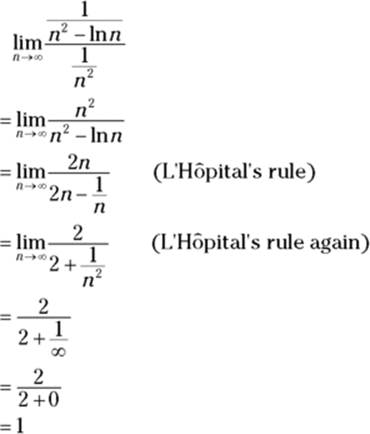
Because the limit is finite and positive and because the benchmark series converges, your series must also converge. Thus, ![]() converges.
converges.
 Use this test for rational functions. The limit comparison test is a good one for series where the general term is a rational function — in other words, where the general term is a quotient of two polynomials.
Use this test for rational functions. The limit comparison test is a good one for series where the general term is a rational function — in other words, where the general term is a quotient of two polynomials.
For example, determine the convergence or divergence of ![]() .
.
1. Determine the benchmark series.
Take the highest power of n in the numerator and the denominator — ignoring any coefficients and all other terms — then simplify. Like this:
![]()
That’s the benchmark series, ![]() , the divergent harmonic series.
, the divergent harmonic series.
2. Take the limit of the ratio of the nth terms of the two series.
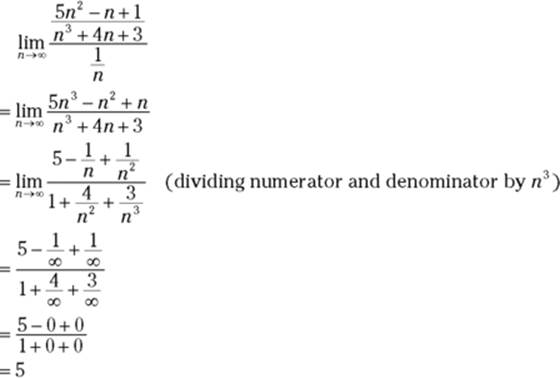
3. Because the limit from Step 2 is finite and positive and because the benchmark series diverges, your series must also diverge.
Thus, ![]() diverges.
diverges.
 Okay, so I’m a rebel. The limit comparison test is always stated as it appears at the beginning of this section, but I want to point out — recklessly ignoring the noble tradition of calculus textbook authors — that in a sense it’s incomplete. The limit, L, doesn’t have to be finite and positive for the test to work. First, if the benchmark series is convergent, and you put it in the denominator of the limit, and the limit is zero, then your series must also converge. Note that if the limit is infinity, you can’t conclude anything. And second, if the benchmark series is divergent, and you put it in the denominator, and the limit is infinity, then your series must also diverge. If the limit is zero, you can’t conclude anything.
Okay, so I’m a rebel. The limit comparison test is always stated as it appears at the beginning of this section, but I want to point out — recklessly ignoring the noble tradition of calculus textbook authors — that in a sense it’s incomplete. The limit, L, doesn’t have to be finite and positive for the test to work. First, if the benchmark series is convergent, and you put it in the denominator of the limit, and the limit is zero, then your series must also converge. Note that if the limit is infinity, you can’t conclude anything. And second, if the benchmark series is divergent, and you put it in the denominator, and the limit is infinity, then your series must also diverge. If the limit is zero, you can’t conclude anything.
The integral comparison test
The third benchmark test involves comparing the series you’re investigating to its companion improper integral (see Chapter 18 for more on improper integrals). If the integral converges, your series converges; and if the integral diverges, so does your series. By the way, to the best of my knowledge, no one else calls this the integral comparison test — but they should because that’s the way it works.
Here’s an example. Determine the convergence or divergence of ![]() . The direct comparison test doesn’t work because this series is smaller than the divergent harmonic series,
. The direct comparison test doesn’t work because this series is smaller than the divergent harmonic series, ![]() . Trying the limit comparison test is the next natural choice, but it doesn’t work either — try it. But if you notice that the series is an expression you know how to integrate, you’re home free (you did notice that, right?). Just compute the companion improper integral with the same limits of integration as the index numbers of the summation — like this:
. Trying the limit comparison test is the next natural choice, but it doesn’t work either — try it. But if you notice that the series is an expression you know how to integrate, you’re home free (you did notice that, right?). Just compute the companion improper integral with the same limits of integration as the index numbers of the summation — like this:
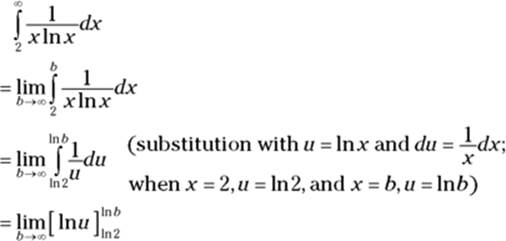
![]()

Because the integral diverges, your series diverges.
After you’ve determined the convergence or divergence of a series with the integral comparison test, you can then use that series as a benchmark for investigating other series with the direct comparison or limit comparison tests.
For instance, the integral test just told you that ![]() diverges. Now you can use this series to investigate
diverges. Now you can use this series to investigate ![]() with the direct comparison test. Do you see why? Or you can investigate, say,
with the direct comparison test. Do you see why? Or you can investigate, say, ![]() with the limit comparison test. Try it.
with the limit comparison test. Try it.
 Don’t forget the integral test. The integral comparison test is fairly easy to use, so don’t neglect to ask yourself whether you can integrate the series expression or something close to it. If you can, it’s a BINGO.
Don’t forget the integral test. The integral comparison test is fairly easy to use, so don’t neglect to ask yourself whether you can integrate the series expression or something close to it. If you can, it’s a BINGO.
By the way, in Chapter 18, you saw the following two improper integrals: ![]() , which diverges and
, which diverges and ![]() , which converges. Look back at Figure 18-1. Now that you know the integral comparison test, you can appreciate the connection between those integrals and their companion p-series: the divergent harmonic series,
, which converges. Look back at Figure 18-1. Now that you know the integral comparison test, you can appreciate the connection between those integrals and their companion p-series: the divergent harmonic series, ![]() , and the convergent p-series,
, and the convergent p-series, ![]() .
.
Here’s the mumbo jumbo for the integral comparison test. Note the fine print.
 Integral comparison test: If
Integral comparison test: If ![]() is positive, continuous, and decreasing for all
is positive, continuous, and decreasing for all ![]() and if
and if ![]() , then
, then ![]() and
and ![]() either both converge or both diverge.
either both converge or both diverge.
The two “R” tests: Ratios and roots
Unlike the three benchmark tests from the previous section, the ratio and root tests don’t compare a new series to a known benchmark. They work by looking only at the nature of the series you’re trying to figure out. They form a cohesive pair because the results of both tests tell you the same thing. If the result is less than 1, the series converges; if it’s more than 1, the series diverges; and if it’s exactly 1, you learn nothing and must try a different test. (As presented here, the ratio and root tests are used for series of positive terms. In other books, you may see a different version of each test that uses the absolute value of the terms. These absolute value versions can be used for series made up of both positive and negative terms. Don’t sweat this; the different versions amount to the same thing.)
The ratio test
The ratio test looks at the ratio of a term of a series to the immediately preceding term. If, in the limit, this ratio is less than 1, the series converges; if it’s more than 1 (this includes infinity), the series diverges; and if it equals 1, the test is inconclusive.
 When to use the ratio test. The ratio test works especially well with series involving factorials like n! or where n is in the power like
When to use the ratio test. The ratio test works especially well with series involving factorials like n! or where n is in the power like ![]() .
.
 Definition of the factorial symbol. The factorial symbol, !, tells you to multiply like this:
Definition of the factorial symbol. The factorial symbol, !, tells you to multiply like this: ![]() . And notice how things cancel when you have factorials in the numerator and denominator of a fraction:
. And notice how things cancel when you have factorials in the numerator and denominator of a fraction: ![]() and
and ![]() . In both cases, everything cancels but the 6. In the same way,
. In both cases, everything cancels but the 6. In the same way, ![]() and
and ![]() ; everything cancels but the
; everything cancels but the ![]() . Lastly, it seems weird, but
. Lastly, it seems weird, but ![]() — just take my word for it.
— just take my word for it.
Try this one: Does ![]() converge or diverge? Here’s what you do. You look at the limit of the ratio of the
converge or diverge? Here’s what you do. You look at the limit of the ratio of the ![]() term to the nth term:
term to the nth term:
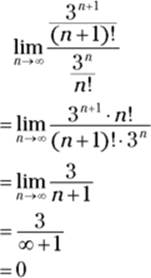
Because this limit is less than 1, ![]() converges.
converges.
Here’s another series: ![]() . What’s your guess — does it converge or diverge? Look at the limit of the
. What’s your guess — does it converge or diverge? Look at the limit of the ![]() term over the nth term:
term over the nth term:
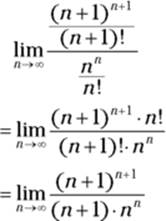
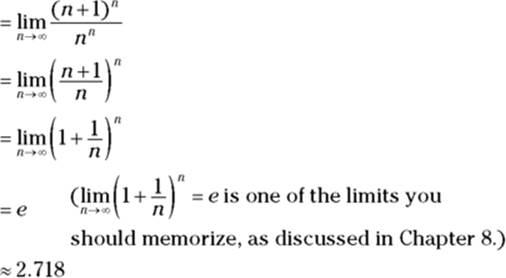
Because the limit is greater than 1, ![]() diverges.
diverges.
The root test
Like the ratio test, the root test looks at a limit. This time you investigate the limit of the nth root of the nth term of your series. The result tells you the same thing as the results of the ratio test: If the limit is less than 1, the series converges; if it’s more than 1 (including infinity), the series diverges; and if the limit equals 1, you learn nothing.
 The root test is a good one to try if the series involves nth powers.
The root test is a good one to try if the series involves nth powers.
Try this one: Does ![]() converge or diverge? Here’s what you do:
converge or diverge? Here’s what you do:

Because the limit is less than 1, the series converges. By the way, you can also do this series with the ratio test, but it’s harder — take my word for it.
 Making a good guess about convergence/divergence: Sometimes it’s useful to make an educated guess about the convergence or divergence of a series before you launch into one or more of the convergence/divergence tests. Here’s a tip that helps with some series. The following expressions are listed from “smallest” to “largest”:
Making a good guess about convergence/divergence: Sometimes it’s useful to make an educated guess about the convergence or divergence of a series before you launch into one or more of the convergence/divergence tests. Here’s a tip that helps with some series. The following expressions are listed from “smallest” to “largest”: ![]() . (The 10 is an arbitrary number; the size of the number doesn’t affect this ordering.) A series with a “smaller” expression over a “larger” one converges, for example,
. (The 10 is an arbitrary number; the size of the number doesn’t affect this ordering.) A series with a “smaller” expression over a “larger” one converges, for example, ![]() or
or ![]() ; and a series with a “larger” expression over a “smaller” one diverges, for instance,
; and a series with a “larger” expression over a “smaller” one diverges, for instance, ![]() or
or ![]() .
.
Alternating Series
In the previous sections, you’ve been looking at series of positive terms. Now you look at alternating series — series where the terms alternate between positive and negative — like this:
![]()
Finding absolute versus conditional convergence
Many divergent series of positive terms converge if you change the signs of their terms so they alternate between positive and negative. For example, you know that the harmonic series diverges:
![]()
But, if you change every other sign to negative, you obtain the alternating harmonic series, which converges:
![]()
By the way, although I’m not going to show you how to compute it, this series converges to ![]() , which equals about 0.6931.
, which equals about 0.6931.
 Definition of conditional convergence: An alternating series is said to be conditionally convergent if it’s convergent as it is but would become divergent if all its terms were made positive.
Definition of conditional convergence: An alternating series is said to be conditionally convergent if it’s convergent as it is but would become divergent if all its terms were made positive.
 Definition of absolute convergence: An alternating series is said to be absolutely convergent if it would be convergent even if all its terms were made positive. And any such absolutely convergent alternating series is also automatically convergent as it is.
Definition of absolute convergence: An alternating series is said to be absolutely convergent if it would be convergent even if all its terms were made positive. And any such absolutely convergent alternating series is also automatically convergent as it is.
Here’s an example. Determine the convergence or divergence of the following alternating series:
![]()
If all these terms were positive, you’d have the familiar geometric series,
![]()
which, by the geometric series rule, converges to 2. Because the positive series converges, the alternating series must also converge (though to a different result — see the following) and you say that the alternating series is absolutely convergent.
The fact that absolute convergence implies ordinary convergence is just common sense if you think about it. The previous geometric series of positive terms converges to 2. If you made all the terms negative, it would sum to ![]() , right? So, if some of the terms are positive and some negative, the series must converge to something between
, right? So, if some of the terms are positive and some negative, the series must converge to something between ![]() and 2.
and 2.
Did you notice that the above alternating series is a geometric series as it is with ![]() ? (Recall that the geometric series rule works for alternating series as well as for positive series.) The rule gives its sum:
? (Recall that the geometric series rule works for alternating series as well as for positive series.) The rule gives its sum:  .
.
The alternating series test
 Alternating series test: An alternating series converges if two conditions are met:
Alternating series test: An alternating series converges if two conditions are met:
1. Its nth term converges to zero.
2. Its terms are non-increasing — in other words, each term is less than or equal to its predecessor (ignoring the minus signs).
(Note that you are free to ignore any number of initial terms when checking whether condition 2 is satisfied.)
Using this simple test, you can easily show many alternating series to be convergent. The terms just have to converge to zero and get smaller and smaller (they rarely stay the same). The alternating harmonic series converges by this test:
![]()
As do the following two series:

 The alternating series test can’t tell you whether a series is absolutely or conditionally convergent. The alternating series test can only tell you whether an alternating series itself converges. The test says nothing about the corresponding positive-term series. In other words, the test cannot tell you whether a series is absolutely convergent or conditionally convergent. To answer that, you must investigate the positive series with a different test.
The alternating series test can’t tell you whether a series is absolutely or conditionally convergent. The alternating series test can only tell you whether an alternating series itself converges. The test says nothing about the corresponding positive-term series. In other words, the test cannot tell you whether a series is absolutely convergent or conditionally convergent. To answer that, you must investigate the positive series with a different test.
Now try a few problems. Determine the convergence or divergence of the following series. If convergent, determine whether the convergence is conditional or absolute.
![]()
1. Check that the nth term converges to zero.
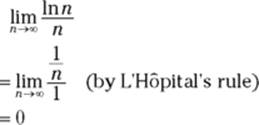
 Consider the nth term. Always check the nth term first because if it doesn’t converge to zero, you’re done — the alternating series and the positive series will both diverge. Note that the nth term test of divergence (see the section on the nth term test) applies to alternating series as well as positive series.
Consider the nth term. Always check the nth term first because if it doesn’t converge to zero, you’re done — the alternating series and the positive series will both diverge. Note that the nth term test of divergence (see the section on the nth term test) applies to alternating series as well as positive series.
2. Check that the terms decrease or stay the same (ignoring the minus signs).
To show that ![]() decreases, take the derivative of the function
decreases, take the derivative of the function ![]() .Remember differentiation? I know it’s been a while.
.Remember differentiation? I know it’s been a while.
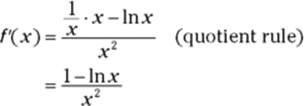
This is negative for all ![]() (because the natural log of anything 3 or greater is more than 1 and
(because the natural log of anything 3 or greater is more than 1 and ![]() , of course, is always positive), so the derivative and thus the slope of the function are negative, and therefore the function is decreasing. Finally, because the function is decreasing, the terms of the series are also decreasing (when
, of course, is always positive), so the derivative and thus the slope of the function are negative, and therefore the function is decreasing. Finally, because the function is decreasing, the terms of the series are also decreasing (when ![]() ). That does it:
). That does it: ![]() converges by the alternating series test.
converges by the alternating series test.
3. Determine the type of convergence.
You can see that for ![]() the positive series,
the positive series, ![]() , is greater than the divergent harmonic series,
, is greater than the divergent harmonic series, ![]() , so the positive series diverges by the direct comparison test. Thus, the alternating series is conditionally convergent.
, so the positive series diverges by the direct comparison test. Thus, the alternating series is conditionally convergent.
 I can’t think of a good title for this warning. If the alternating series fails to satisfy the second requirement of the alternating series test, it does not follow that your series diverges, only that this test fails to show convergence.
I can’t think of a good title for this warning. If the alternating series fails to satisfy the second requirement of the alternating series test, it does not follow that your series diverges, only that this test fails to show convergence.
You’re getting so good at this, so how about another problem? Test the convergence of ![]() . Because the positive series
. Because the positive series ![]() resembles the convergent p-series,
resembles the convergent p-series, ![]() , you guess that it converges.
, you guess that it converges.
 You might want to consider the positive series first. If you think you can show that the positive series converges or diverges, you may want to try that before using the alternating series test, because …
You might want to consider the positive series first. If you think you can show that the positive series converges or diverges, you may want to try that before using the alternating series test, because …
· You may have to do this later anyway to determine the type of convergence, and
· If you can show that the positive series converges, you’re done in one step, and you’ve shown that the alternating series is absolutely convergent.
So try to show the convergence of the positive series ![]() . The limit comparison test seems appropriate here, and
. The limit comparison test seems appropriate here, and ![]() is the natural choice for the benchmark series, but with that benchmark, the test fails — try it. When this happens, you can sometimes get home by trying a larger convergent series. So try the limit comparison test with the convergent p-series,
is the natural choice for the benchmark series, but with that benchmark, the test fails — try it. When this happens, you can sometimes get home by trying a larger convergent series. So try the limit comparison test with the convergent p-series, ![]() :
:

Because this limit is zero, the positive series ![]() converges (see the section “The limit comparison test”); and because the positive series converges, so does the given alternating series. Thus,
converges (see the section “The limit comparison test”); and because the positive series converges, so does the given alternating series. Thus, ![]() converges absolutely.
converges absolutely.
One last problem and I’ll let you go. Test the convergence of ![]()
![]() This is an easy one.
This is an easy one.
The nth term of this series (ignoring the minus signs) converges to 1 (it’s a L’Hôpital’s rule no-brainer), so you’re done. Because the nth term does not converge to zero, the series diverges by the nth term test.
Keeping All the Tests Straight
You now probably feel like you know — have a vague recollection of? — a gazillion convergence/divergence tests and are wondering how to keep track of all of them. Actually, I’ve given you only ten tests in all — that’s a nice, easy-to-remember round number. Here’s how you can keep the tests straight.
First are the three series with names: the geometric series, p-series, and telescoping series. A geometric series converges if ![]() . A p-series converges if
. A p-series converges if ![]() A telescoping series converges if the second “half term” converges to a finite number.
A telescoping series converges if the second “half term” converges to a finite number.
Next are the three comparison tests: the direct comparison, limit comparison, and integral comparison tests. All three compare a new series to a known benchmark series. If the benchmark series converges, so does the series you’re investigating; if the benchmark diverges, so does your new series.
And then you have the two “R” tests: the ratio test and the root test. Both analyze just the series in question instead of comparing it to a benchmark series. Both involve taking a limit, and the results of both are interpreted the same way. If the limit is less than 1, the series converges; if the limit is greater than 1, the series diverges; and if the limit equals 1, the test is inconclusive.
Finally, you have two tests that form bookends for the other eight — the nth term test of divergence and the alternating series test. These two form a coherent pair. You can remember them as the nth term test of divergence and the nth term test of convergence. The alternating series test involves more than just testing the nth term, but this is a good memory aid.
Well, there you have it: Calculus, schmalculus.